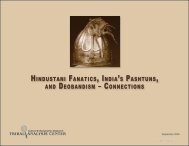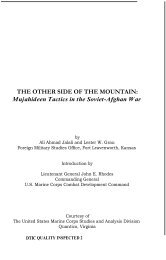Baranzai: Located in Sistan va Baluchestan. They may be of Pashtun origin.The Baluch <strong>and</strong> <strong>the</strong> Brahui - <strong>and</strong> <strong>the</strong>ir RebellionsDamani: Located in Sistan va Baluchestan. The Damani are divided into <strong>the</strong> Gamshadzai <strong>and</strong> Yarmuhammadzai sections. Some may also belocated in Baluchistan, Pakistan.Hot: Located in along <strong>the</strong> coast in Sistan va Baluchestan, Iran <strong>and</strong> also in Mekran Division, Baluchistan, Pakistan. As of 1923, <strong>the</strong>y werereported to be <strong>the</strong> largest Baluch tribe living in Iran. Many of <strong>the</strong>m were nomadic.Ismailzai: Located in Sistan va Baluchestan. Most are nomadic. The Reki tribe borders <strong>the</strong>m to <strong>the</strong> east. They are noted to be stricter in <strong>the</strong>irreligious observances than <strong>the</strong>ir neighbors.Kurd (aka Kurt): The Kurds are thought to be identifiable with <strong>the</strong> Kurds currently located in northwestern Iran, nor<strong>the</strong>rn Iraq, <strong>and</strong> sou<strong>the</strong>rnTurkey. They were reportedly induced (presumably by <strong>the</strong> Shah of Persia) to settle in Sarhad, Sistan va Baluchestan in order to keep <strong>the</strong> Baluch incheck. However, <strong>the</strong>y got along relatively well with <strong>the</strong> Baluch <strong>and</strong> conducted raids against Persian as well as Baluch territory. While acknowledging<strong>the</strong>ir Kurdish origins, <strong>the</strong>y now refer to <strong>the</strong>mselves as Baluch.Lashari: The Lasharis are a well-known Baluch tribe in Baluchistan, Pakistan, but some are nomadic <strong>and</strong> live in Iran around Bampur in Sistanva Baluchestan, Iran. The relationship between <strong>the</strong> Lasharis in Iran <strong>and</strong> Pakistan is unknown.Nausherwani: Though not originally a Baluch tribe, some sources list <strong>the</strong> Nausherwanis as such or as a Rind Baluch clan. The Nausherwanislisted as Baluch lived in Sistan va Baluchestan as of 2003. They enjoyed close ties to <strong>the</strong> Nausherwanis in Baluchistan, Pakistan.Rais: Located primarily along <strong>the</strong> Iranian coast in Sistan va Baluchestan. Some also live in Mekran Division along <strong>the</strong> Pakistan coast inBaluchistan.Reki (aka Rek, Rigi, Riki): As of <strong>the</strong> late 1800s, <strong>the</strong> Reki were said to be numerous <strong>and</strong> scattered over sou<strong>the</strong>rn Iran <strong>and</strong> between Kuh-i-TaftanMountain <strong>and</strong> <strong>the</strong> Helm<strong>and</strong> River. They were primarily herders. Reki are also located in Afghanistan, but <strong>the</strong>ir relationship with <strong>the</strong> Iranian Reki isunknown.Taukhi: Located in Sistan va Baluchestan. Many of <strong>the</strong> Baluch tribes in Iran hearken back to Taukhi origins. It is unclear if Taukhi is a separatetribe or a hereditary group encompassing several tribes.GeographyAccording to tradition <strong>and</strong> historical evidence, <strong>the</strong> Baluch entered <strong>the</strong>ir present territory from <strong>the</strong> west—some legends claim from as far westas Syria—arriving in Mekran in approximately <strong>the</strong> 7 th century. From <strong>the</strong>re <strong>the</strong>y spread north into Kalat Division <strong>and</strong> east into Sindh <strong>and</strong> PunjabProvinces. They currently inhabit parts of Baluchistan, Sindh, <strong>and</strong> Punjab Provinces, Pakistan, parts of sou<strong>the</strong>astern Iran, <strong>and</strong> parts of sou<strong>the</strong>rn <strong>and</strong>northwestern Afghanistan. Some also live in <strong>the</strong> Middle East, <strong>and</strong> some may live in Turkmenistan <strong>and</strong> Tajikistan. Pashtun tribes border <strong>the</strong>m on <strong>the</strong>north <strong>and</strong> nor<strong>the</strong>ast, Punjabis <strong>and</strong> Sindhis on <strong>the</strong> east, <strong>and</strong> Persians on <strong>the</strong> west. The Brahui ethnic group, residing in Kalat Division, interrupts <strong>the</strong><strong>Tribal</strong> <strong>Analysis</strong> <strong>Center</strong>, 6610-M Mooretown Road, Box 159. Williamsburg, VA, 23188
The Baluch <strong>and</strong> <strong>the</strong> Brahui - <strong>and</strong> <strong>the</strong>ir RebellionsBaluch tribal extent within Baluchistan. Most Baluch practice limited nomadism, though some are settled agriculturalists. The Baluch inhabit an areathat varies geographically from mountains, to plains, to deserts, <strong>and</strong> climatically from semi-arid to hyper-arid.As of 1981, approximately half of <strong>the</strong>Baluch resided in Baluchistan Province. A highpercentage resided in Punjab <strong>and</strong> Sindh Provinces<strong>and</strong> Sistan va Baluchestan Province, Iran, <strong>and</strong>fewer lived in Nimruz, Helm<strong>and</strong>, Badghis, <strong>and</strong>Jowzjan Provinces, Afghanistan <strong>and</strong> <strong>the</strong> North-West Frontier Province, Pakistan. Some havemigrated to <strong>the</strong> Middle East, primarily to Oman,<strong>and</strong> Baluch speakers can be found in Turkmenistan<strong>and</strong> Tajikistan. As of <strong>the</strong> early 1900s, one quarterof <strong>the</strong> population of Sindh Province was estimatedto be Baluch. As of <strong>the</strong> late 1800s, <strong>the</strong> Baluchheld most of Dera Ghazi Khan District, PunjabProvince. However, as of <strong>the</strong> early 1900s, <strong>the</strong>Baluch living to <strong>the</strong> east of <strong>the</strong> Indus River inSindh <strong>and</strong> Punjab no longer spoke <strong>the</strong> Baluchilanguage <strong>and</strong> had more or less assimilated with<strong>the</strong>ir neighbors.Traditionally, many Baluch were nomadicherders who practiced limited agriculture. Thoughcultivation has increased with improved irrigation,many Baluch, especially in <strong>the</strong> Chagai area ofQuetta Division, are still nomads. As of <strong>the</strong>early 1900s, most Baluch in Zhob Division werenomads, though <strong>the</strong>y were beginning to acquire l<strong>and</strong>. Even settled Baluch tend to view <strong>the</strong>mselves as a nomadic people, <strong>the</strong> term “Baluch” oftenbeing used to refer to nomads in general. During times of droughts, normally settled Baluch might migrate to a more prosperous tribal area, where<strong>the</strong>y would receive assistance from fellow tribesmen. Nomadic Baluch live in blanket tents called ghedans/gedans/gidans, made of goat hair <strong>and</strong>generally consisting of 11 pieces, about three feet wide by 15-24 feet long. The pieces are stitched toge<strong>the</strong>r <strong>and</strong> stretched over curved wooden poles.Wealthy families use a separate ghedan to shelter <strong>the</strong>ir livestock, but most families live with <strong>the</strong>ir animals in <strong>the</strong> same ghedan. A group of ghedansconstituted a tuman. Some hill nomads live in small groups in three to four-foot high loose stone enclosures covered by a temporary roof of mattingor leaves. The Kachhi Plain in Nasirabad Division is a common winter residence for nomadic Baluch, Brahui, <strong>and</strong> o<strong>the</strong>r tribes.<strong>Tribal</strong> <strong>Analysis</strong> <strong>Center</strong>, 6610-M Mooretown Road, Box 159. Williamsburg, VA, 23188
















